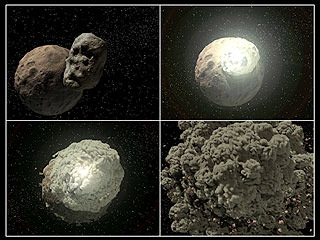According to a new study left by the Spitzer Space Telescope, a moon like the Earth's - formed as a result of giant collisions - is not common in the universe, and that it is found in perhaps 5-10 percent of the solar systems

"When a moon is formed as a result of a violent collision, the dust may be scattered everywhere," says Nadia Gorlova of the University of Florida in Gainesville. Gorlova is the lead researcher behind the study published Nov. 20 in the Astrophysical Journal. "If many moons were formed in this way, we should have seen dust around many stars, but we didn't," she explains.
It is hard to imagine the Earth without the Moon. Our white neighbor was the subject of art, myths and poetry, wolves howled at him, and humans left their footprints on his bottom. It is possible that life evolved from the sea to the land thanks to the tidal waves created by the gravitational force of the moon.
The scientists estimate that the moon developed about 30-50 million years after the formation of the sun and after the rocky planets began to take shape. A body the size of Mars crashed into the young Earth, tearing pieces of its mantle. Some of these fragments were blown into orbit around the Earth and eventually solidified and became the Moon as we know it today. The rest of the moons in the solar system formed simultaneously with their planet or were captured by that planet's gravity.
The chances are 5-10 percent
Gorlova and her colleagues observed the dust signals from similar events around 400 stars, all of which are about 30 million years old—about the age our sun was when Earth's moon formed. They found that only 1 in 400 of these stars contained a long dust tail. Even taking into account the time it takes for dust to stick together, and the age range in which moon formation occurs, the scientists calculated the chances of a solar system forming a moon like this Earth's at 5 to 10 percent.
"We don't know if the collisions we've witnessed around one star are actually going to produce a moon, so it's possible that moon-forming events are much less common than what our calculations show," says George Reika of the University of Arizona in Tucson, a co-author of the study.
On top of that, the observations tell astronomers that the planet-building process itself slowed down about 30 million years after the formation of the Sun. Like our Moon, rocky planets are built through massive collisions that scatter dust around.
Current opinion holds that this process takes between 10 and 50 million years after the formation of the star. The fact that Gorolova and team found one star out of 400 that has collisions in its system within a period of 30 million years after its formation shows that at least most of them have completed the planet-making stage.
"The astronomers observed young stars that had dust swirling around them for over 20 million years," Gorlova says. "But these stars are usually so young that their dust could be leftovers from the planet-forming process. The star we found is older, about the age our Sun was when it finished the process of creating planets, and the Earth-Moon system had just formed in a collision.
For moon lovers, the news is not so bad. One thing is certain, moons are formed in a variety of ways, and although most of the rocky planets in the universe do not hold a moon like Earth's, astronomers believe that there are still billions of rocky planets, and even 5 to 10 percent of those billion planets means many moons. Researchers from the University of Arizona and the Southern European Observatory in Chile also participated in the study.
For the original news on the NASA website

2 תגובות
For those who love Asimov
He proposed the idea that life on Earth developed only thanks to the size of our moon